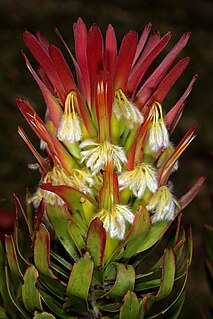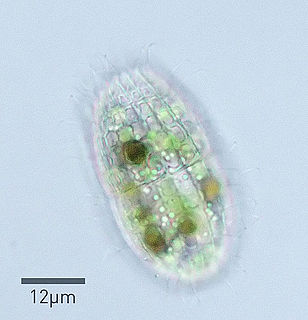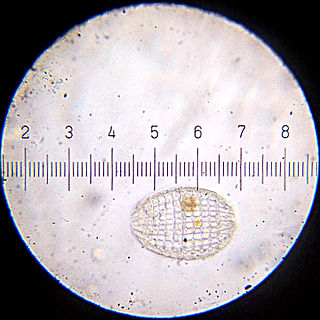
Mimetes, the pagoda, is a genus of evergreen shrubs or small trees 0.5–6 m (1.6–19.7 ft) high, with thirteen species assigned to the family Proteaceae. This genus, as with other proteas, is popular with nectarivorous birds such as the Cape sugarbird and several sunbird species. All species of Mimetes are endemic to the Cape Floristic Region of South Africa.

Jahnoporus is a genus of fungi in the family Albatrellaceae. There are two species in the genus, which have a widespread distribution in northern temperate regions. The type species, J. hirtus, was transferred to this genus in 1980; it was formerly known as Piptoporus hirtus.

Mimetes hirtus is an upright, evergreen shrub of 1½–2 m high from the family Proteaceae. It has upright, overlapping, (broadly) lance-shaped leaves, without teeth, but with one thickened pointy tip. It has cylindric inflorescences topped by a pine apple-like tuft of pinkish-brownish, smaller and more or less horizontal leaves. The flowerheads are tightly enclosed by yellow, red-tipped bracts, only the 9–14 long red styles and the whitish silky tips of the perianth sticking out. It is primarily pollinated by the Cape sugarbird. It is an endemic species of the southwest of the Western Cape province of South Africa, and grows in wet zones at the base of south facing mountain slopes. Flower heads may be found from May to November, but peaks in July and August. The species has several vernacular names of which marsh pagoda seems to be used most.

Scutiger is a genus of fungi in the family Albatrellaceae, which includes S. oregonensis, the fungus tuber.

Coleps is a genus of ciliates in the class Prostomatea with barrel-shaped bodies surrounded by regularly arranged plates composed of calcium carbonate.

Tetropismenus hirtus is a species of ulidiid or picture-winged fly in the genus Tetropismenus of the family Ulidiidae.

Prostomatea is a class of ciliates. It includes the genera Coleps and Pelagothrix.

Plagiobothrys hirtus, the rough popcornflower, is a plant species with only about a dozen reportedly extant occurrences, all within the Umpqua River watershed in Douglas County, Oregon. It is federally listed endangered in the United States of America. In fact P. hirtus is now considered to be one of the top three most endangered vascular plant species in the Northwest. The state of Oregon has ranked this plant as its number one recovery priority due to its high degree of threat as well as its high rating in recovery potential. Its recovery depends on conservation of existing populations as well as reintroduction of new populations in protected and species-appropriate areas.

Hemicrepidius hirtus is a species of click beetle belonging to the family Elateridae.
Acartus is a genus of beetles of the tribe Acanthocinini of the subfamily Lamiinae, in the family Cerambycidae, containing the following species:
Acartus hirtus is a species of beetle in the family Cerambycidae. It was described by Farhoeus in 1872. It is the type species for the genus Acartus.

Emus is a genus of insect. There are four known species within this genus:

Nassarius hirtus, common name the rough nassa, is a species of sea snail, a marine gastropod mollusk in the family Nassariidae, the Nassa mud snails or dog whelks.
Olios hirtus, is a species of spider of the genus Olios. It is endemic to Sri Lanka.
Labops hirtus is a species of plant bug in the family Miridae. It is found in North America.
Xylocoris hirtus is a species of bugs in the family Lyctocoridae. It is found in North America.
Involvulus hirtus is a species of leaf rolling weevil in the beetle family Attelabidae.
Eurysphindus hirtus is a species of cryptic slime mold beetle in the family Sphindidae. It is found in North America.

Megalomus hirtus, common name bordered brown lacewing, is a species of brown lacewings in the family Hemerobiidae.

Hibiscus hirtus or Lesser Mallow is a species of Hibiscus found in India. It is an perennial deciduous shrub with a maximum height about 1 meter.












